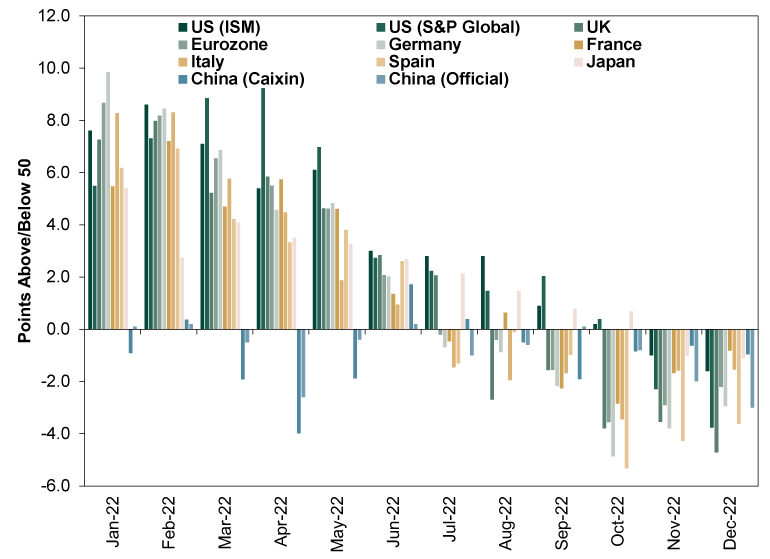Personal Wealth Management / Market Analysis
A Look Around the World at Manufacturing PMIs Entering 2023
Heavy industry’s slump isn’t news for stocks.
The New Year is officially underway, but 2022 still lingers on in a sense, as December’s economic data are only just starting to come out. First up: Manufacturing Purchasing Managers’ Indexes (PMIs), which showed factories worldwide finished the year in the doldrums—surprising no one. Not only are manufacturing’s troubles well-documented, but heavy industry is uniquely vulnerable to last year’s biggest headwinds. The good news? With those headwinds widely known and now starting to fade, global markets should be poised to begin pricing in an economic recovery much sooner than people seem to anticipate.
Exhibit 1 rounds up the major manufacturing PMIs. As you will see, all remained under 50, the line between growth and contraction. That extends the trend that materialized around midyear.
Exhibit 1: Around the World in Manufacturing PMIs

Source: FactSet, as of 1/4/2023.
In our view, geographic trends highlight the causality. China started and ended the year weak, due first to the continuation of its Zero-COVID policies and then, as the year closed, the big COVID wave that followed the easing of most restrictions. It is increasingly an outlier globally but will probably come back in line with the rest of the world later this year as it moves past the winter COVID surge. Elsewhere, the UK and eurozone were first to slip into contraction, which we think ties to their comparatively higher energy costs. Manufacturing is quite energy-intensive, making factory output especially susceptible to rising power prices. Germany unsurprisingly got it the worst since natural gas is a key feedstock for its mighty chemical industry, hitting it disproportionately as natural gas prices surged after the West’s response to Russia’s Ukraine invasion hit supply in the eurozone. But by yearend, all major developed economies’ manufacturing sectors were in contraction, hit by higher operating costs and input prices as well as reduced demand from clients that had their own issues trying to weather the inflation storm.
That is all the bad news—and it is all backward-looking. Stocks, however, look out to the next 3 – 30 months. In that stretch, the issues that hampered factories as 2022 wound down look highly likely to improve. Energy costs are down—way down—with even benchmark European natural gas prices below pre-invasion levels. Gas shortage talk has died down significantly, reducing the likelihood of rationing and factory outages in Europe. On our shores, lower gasoline prices mean lower transit costs, enabling more goods to move around the country. Commodity prices are down across the board. Per the PMIs, input and output price increases have continued moderating significantly. Forward-looking inflation indicators—chiefly, slowing in broad money supply growth—suggest that should continue. Meanwhile, loan growth remains resilient across the developed world, suggesting households and businesses should have plenty of capital to deploy as their inflation concerns ease.
We know this doesn’t square with all the economic pessimism dominating the world, evident once again in the IMF’s latest comments about one-third of the world being in decline, not to mention the drumbeat of surveys showing recession is the baseline forecast. But that is the point. Markets move most on the gap between expectations and reality over the foreseeable future. Expectations are quite low, mostly because people are extrapolating the current weakness forward. But actual forward-looking indicators suggest some improvement is in the offing even in the areas seemingly hit hardest by last year’s dynamics—improvement that doesn’t seem to be factored into sentiment right now. Seems to us like there is a lot of room for positive economic surprise to buoy stocks.
When that will happen, we can’t say. It may already have begun in mid-October. Turning points are clear only in hindsight. Maybe stocks move well in advance of any notable improvement in the data, or maybe there is further downside ahead if data stay bad a while longer. After a year in which markets seemed to dwell on bad news much more than good, who can say when that preoccupation with the negative will flip. But looking purely at the economic driver, we see much more positive surprise potential ahead than negative. At some point, if markets are at all efficient, that should eventually show up in prices.
If you would like to contact the editors responsible for this article, please message MarketMinder directly.
*The content contained in this article represents only the opinions and viewpoints of the Fisher Investments editorial staff.
Get a weekly roundup of our market insights
Sign up for our weekly e-mail newsletter.

You Imagine Your Future. We Help You Get There.
Are you ready to start your journey to a better financial future?

Where Might the Market Go Next?
Confidently tackle the market’s ups and downs with independent research and analysis that tells you where we think stocks are headed—and why.





